Nano-Enhanced Phase Reinforced Magnesium Matrix Composites: A Review of the Matrix, Reinforcement, Interface Design, Properties and Potential Applications
Abstract
:1. Introduction
2. Research and Development of Matrix in Magnesium Matrix Composites
2.1. Mg-Al-Zn (AZ) Matrix Composites
2.2. Research and Development of Mg-RE (WE) Matrix Composites
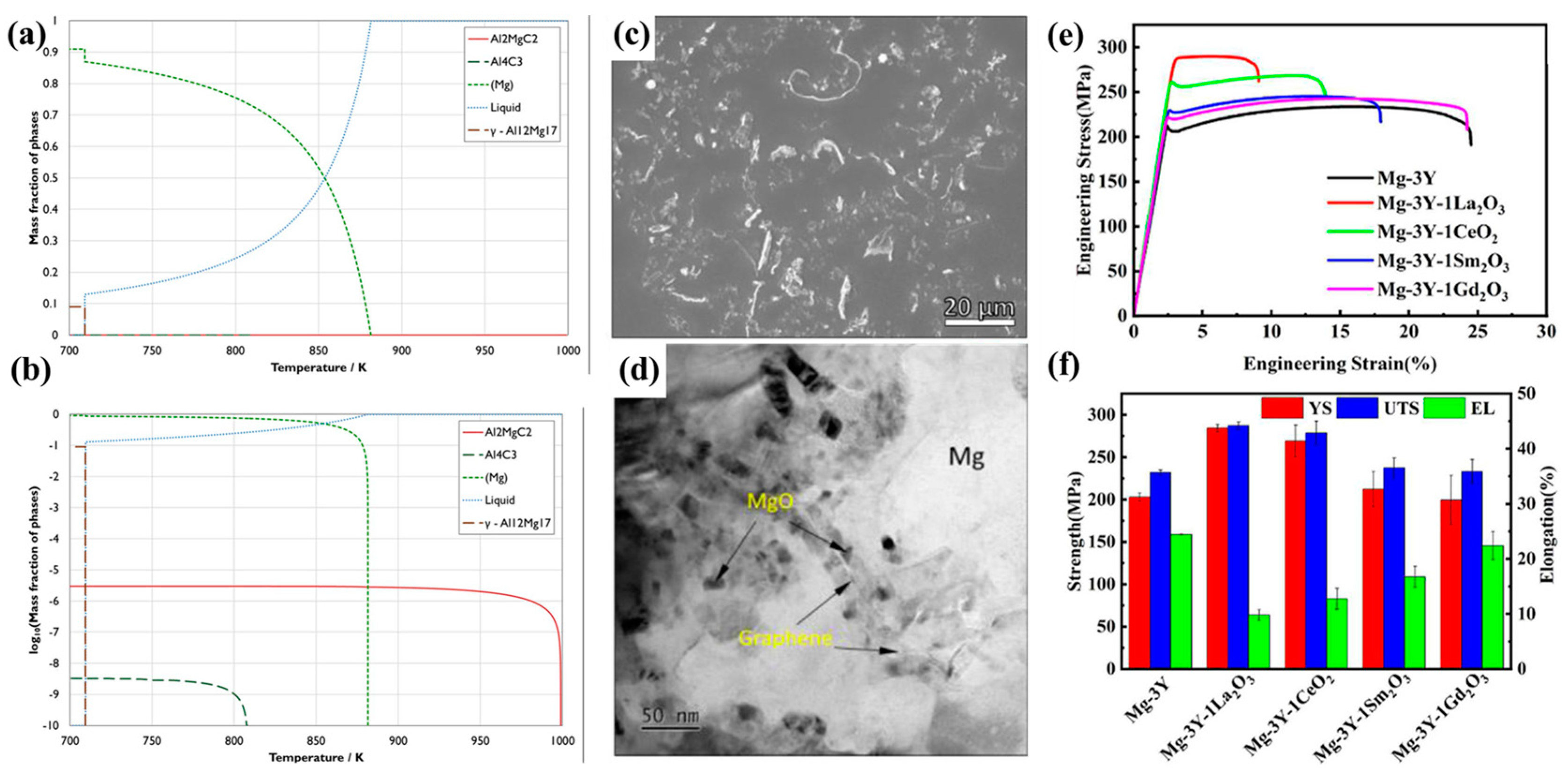
2.3. Research and Development of Mg-Li Matrix Composites
2.4. Mg-Zr Matrix Composites
2.5. Comparison and Summary of Various Matrixes in Magnesium Matrix Composites
3. Reinforcements of Magnesium Matrix Composites
3.1. Selection of Reinforcements
3.1.1. Metallic-Reinforced Mg-Based Composites
3.1.2. Ceramic-Reinforced Mg-Based Composites
3.1.3. Carbon-Reinforced Mg-Based Composites
3.2. The Physical Properties and Comparative Analysis of the Main Ceramic Reinforced Phases
3.2.1. Alumina (Al2O3)
3.2.2. Silicon Carbide (SiC)
3.2.3. Titanium Diboride (TiB2)
3.2.4. Aluminum Nitride (AlN)
3.2.5. Tungsten Carbide (WC)
3.2.6. Bio-Ceramic Reinforcements
3.2.7. Other Reinforcements
3.3. Effect of Ceramic Particle Size on Microstructure and Properties of Magnesium Matrix Composites
4. Interface Design and Control between Reinforcement and Magnesium Matrix
4.1. Factors Affecting the Interface between Reinforcement and Magnesium Matrix
4.1.1. Wettability
4.1.2. Reactions between Reinforcement and Magnesium Matrix
4.2. Methods to Improve the Interfacial Bonding Strength of Nano-Reinforced Magnesium Matrix Composites
5. Properties and Applications of Nanoparticle-Reinforced Magnesium Matrix Composites
5.1. Mechanical Properties of Nanoparticle-Reinforced Magnesium Matrix Composites
5.2. Hardness and Abrasion Resistance of Nanoparticle-Reinforced Magnesium Matrix Composites
5.3. Corrosion Resistance of Nanoparticle-Reinforced Magnesium Matrix Composites
5.4. Biological Properties of Nanoparticle-Reinforced Magnesium Matrix Composites
5.5. Creep Behavior of Nanoparticle-Reinforced Magnesium Matrix Composites
6. Conclusions
Author Contributions
Funding
Institutional Review Board Statement
Informed Consent Statement
Data Availability Statement
Conflicts of Interest
References
- Karakulak, E. A review: Past, present and future of grain refining of magnesium castings. J. Magnes. Alloys 2019, 7, 355–369. [Google Scholar] [CrossRef]
- Sui, S.; Guo, S.; Ma, D.; Guo, C.; Wu, X.; Zhang, Z.; Xu, C.; Shechtman, D.; Remennik, S.; Safranchik, D.; et al. Additive manufacturing of magnesium and its alloys: Process-formability-microstructure-performance relationship and underlying mechanism. Int. J. Extrem. Manuf. 2023, 5, 042009. [Google Scholar] [CrossRef]
- Saikrishna, N.; Reddy, G.P.K.; Munirathinam, B.; Dumpala, R.; Jagannatham, M.; Sunil, B.R. An investigation on the hardness and corrosion behavior of MWCNT/Mg composites and grain refined Mg. J. Magnes. Alloys 2018, 6, 83–89. [Google Scholar] [CrossRef]
- Prasad, S.V.S.; Prasad, S.B.; Verma, K.; Mishra, R.K.; Kumar, V.; Singh, S. The role and significance of Magnesium in modern day research—A review. J. Magnes. Alloys 2022, 10, 1–61. [Google Scholar]
- Guan, H.; Xiao, H.; Ouyang, S.; Tang, A.; Chen, X.; Tan, J.; Feng, B.; She, J.; Zheng, K.; Pan, F. A review of the design, processes, and properties of Mg-based composites. Nanotechnol. Rev. 2022, 11, 712–730. [Google Scholar] [CrossRef]
- Wang, B.-J.; Xu, D.-K.; Wang, S.; Xu, X.-B.; Han, E.-H. Effect of phosphate conversion film on fatigue and corrosion fatigue behavior of an as-rolled Mg–3.08Zn–0.83Al (in wt.%) alloy. J. Iron Steel Res. Int. 2023, 30, 2557–2565. [Google Scholar] [CrossRef]
- Ma, C.; Wang, D.; Liu, J.; Peng, N.; Shang, W.; Wen, Y. Preparation and property of self-sealed plasma electrolytic oxide coating on magnesium alloy. Int. J. Miner. Metall. Mater. 2023, 30, 959–969. [Google Scholar] [CrossRef]
- Zhang, Y.-Z.; Dong, B.-X.; Wang, C.-G.; Yan, B.-C.; Yang, H.-Y.; Qiu, F.; Shu, S.-L.; Jiang, Q.-C. Review on manufacturability and strengthening mechanisms of particulate reinforced Mg composites. J. Mater. Res. Technol. 2024, 30, 3152–3177. [Google Scholar] [CrossRef]
- Suhuddin, U.F.H.R.; Mironov, S.; Sato, Y.S.; Kokawa, H.; Lee, C.W. Grain structure evolution during friction-stir welding of AZ31 magnesium alloy. Acta Mater. 2009, 57, 5406–5418. [Google Scholar] [CrossRef]
- Tang, S.L.; Gao, Y.M.; Li, Y.F. Recent developments in fabrication of ceramic particle reinforced iron matrix wear resistant surface composite using infiltration casting technology. Ironmak. Steelmak. 2014, 41, 633–640. [Google Scholar] [CrossRef]
- Fan, K.; Wang, G.Z.; Xuan, F.Z.; Tu, S.T. Effects of work hardening mismatch on fracture resistance behavior of bi-material interface regions. Mater. Des. 2015, 68, 186–194. [Google Scholar] [CrossRef]
- Chen, W.; Yu, W.; Zhang, P.; Pi, X.; Ma, C.; Ma, G.; Zhang, L. Fabrication and performance of 3D co-continuous magnesium composites reinforced with Ti2AlNx MAX phase. Int. J. Miner. Metall. Mater. 2022, 29, 1406–1412. [Google Scholar] [CrossRef]
- Wang, Z.; Nie, K.; Deng, K.; Han, J. Effect of extrusion on the microstructure and mechanical properties of a low-alloyed Mg−2Zn−0.8Sr−0.2Ca matrix composite reinforced by TiC nano-particles. Int. J. Miner. Metall. Mater. 2022, 29, 1981–1990. [Google Scholar] [CrossRef]
- Mirzadeh, H. Surface metal-matrix composites based on AZ91 magnesium alloy via friction stir processing: A review. Int. J. Miner. Metall. Mater. 2023, 30, 1278–1296. [Google Scholar] [CrossRef]
- Qian, X.; Yang, H.; Hu, C.; Zeng, Y.; Huang, Y.; Shang, X.; Wan, Y.; Jiang, B.; Feng, Q. Effect of potential difference between nano-Al2O3 whisker and Mg matrix on the dispersion of Mg composites. Int. J. Miner. Metall. Mater. 2023, 30, 104–111. [Google Scholar] [CrossRef]
- Lin, Z.; Su, Y.; Yang, J.; Qiu, C.; Chai, X.; Liu, X.; Ouyang, Q.; Zhang, D. Configuration feature extraction and mechanical properties prediction of particle reinforced metal matrix composites. Compos. Commun. 2023, 42, 101688. [Google Scholar] [CrossRef]
- Lei, J.; Ma, L.; Cai, Z.; Jia, W.; Zhi, C.; Yuan, Y.; Pan, H.; Xie, H. Interfacial fracture characteristics of Mg/Al composite plates with different thickness ratios by asymmetrical rolling with differential temperature rolls. Mater. Sci. Eng. A 2023, 869, 144764. [Google Scholar] [CrossRef]
- Fu, Q.; Liang, W.; Huang, J.; Jin, W.; Guo, B.; Li, P.; Xu, S.; Chu, P.K.; Yu, Z. Research perspective and prospective of additive manufacturing of biodegradable magnesium-based materials. J. Magnes. Alloys 2023, 11, 1485–1504. [Google Scholar] [CrossRef]
- Xu, N.; Ren, Z.; Qiu, Z.; Lu, Z.; Wang, D.; Shen, J.; Song, Q.; Zhao, J.; Bao, Y. Microstructure and mechanical properties of carbon nano-onions reinforced Mg-based metal matrix composite prepared by friction-stir processing. Mater. Today Commun. 2023, 35, 105552. [Google Scholar] [CrossRef]
- Yu, W.; Li, X.; Vallet, M.; Tian, L. High temperature damping behavior and dynamic Young’s modulus of magnesium matrix composite reinforced by Ti2AlC MAX phase particles. Mech. Mater. 2019, 129, 246–253. [Google Scholar] [CrossRef]
- Jayasathyakawin, S.; Ravichandran, M.; Ismail, S.O.; Veerappan, G. Effects of ZnO addition on the microstructure/corrosion, wear and mechanical properties of sintered Mg-Al matrix composites. J. Alloys Compd. 2023, 958, 170500. [Google Scholar] [CrossRef]
- Zhang, Q.; Tian, W.; Zhou, J.; Li, Y.; Qi, L. An emerging class of 3D GNPs&MWCNTs structure of Mg matrix composites with improved thermal conductivity. J. Magnes. Alloys, 2023, in press.
- Yang, C.; Qi, L.; Chao, X.; Wang, J.; Ge, J. Highly thermal conductive Csf/Mg composites by in-situ constructing the unidirectional configuration of short carbon fibers. Chem. Eng. J. 2023, 470, 144327. [Google Scholar] [CrossRef]
- Liang, W.; Lian, L.; Lin, Z.; Liu, Y. Structure-function integrated Mg-Ti composites as seawater battery anode with excellent mechanical and electrochemical properties. Electrochim. Acta 2023, 464, 142885. [Google Scholar] [CrossRef]
- Deffrennes, G.; Gardiola, B.; Lomello-Tafin, M.; Pasturel, A.; Pisch, A.; Andrieux, J.; Schmid-Fetzer, R.; Dezellus, O. Thermal stability of Al2MgC2 and thermodynamic modeling of the Al–C–Mg system—Application to grain refinement of Mg–Al alloys. Calphad 2019, 67, 101678. [Google Scholar] [CrossRef]
- Xu, Z.Y.; Fang, C.F.; Li, C.J.; Wang, R.; Zhang, X.P.; Tan, J.; Wang, Y.M. GO/MgO/Mg interface mediated strengthening and electromagnetic interference shielding in AZ31 composite. J. Magnes. Alloys 2023, 11, 3800–3814. [Google Scholar] [CrossRef]
- Wang, M.; Xie, G.; Liu, D.; Yang, Z.; Fan, R.; Sheng, J.; Wang, G.; Cui, B. Microstructure and tribological properties of Mg matrix composite reinforced with modified graphene. J. Mater. Res. Technol. 2023, 25, 6542–6549. [Google Scholar] [CrossRef]
- Li, Y.; Zhang, A.; Li, C.; Xie, H.; Jiang, B.; Dong, Z.; Jin, P.; Pan, F. Recent advances of high strength Mg-RE alloys: Alloy development, forming and application. J. Mater. Res. Technol. 2023, 26, 2919–2940. [Google Scholar] [CrossRef]
- Ren, L.; Zhou, X.; Wang, T.; Li, Y.; Le, Q.; Liao, Q. Study of microstructure and mechanical properties of Mg–3Y-1REmOn composites by Y-REmOn (RE=La, Ce, Sm, Gd) in-situ reaction. J. Mater. Res. Technol. 2023, 24, 2145–2154. [Google Scholar] [CrossRef]
- Wei, C.; Gu, H.; Gu, Y.; Liu, L.; Huang, Y.; Cheng, D.; Li, Z.; Li, L. Abnormal interfacial bonding mechanisms of multi-material additive-manufactured tungsten–stainless steel sandwich structure. Int. J. Extrem. Manuf. 2022, 4, 025002. [Google Scholar] [CrossRef]
- Wu, G.; Wang, C.; Sun, M.; Ding, W. Recent developments and applications on high-performance cast magnesium rare-earth alloys. J. Magnes. Alloys 2021, 9, 1–20. [Google Scholar] [CrossRef]
- Sun, J.; Ding, D.; Liu, W.; Wu, G.; Liu, H.; Wei, G.; Liu, H. Strength and elastic modulus enhancement in Mg-Li-Al matrix composites reinforced by ex situ TiB2 particles via stir casting. J. Magnes. Alloys, 2022, in press. [CrossRef]
- Li, X.; Le, Q.; Zhou, X.; Cheng, C.; Cao, Y.; Chen, X.; Wang, P.; Ren, L.; Li, D. The strengthening mechanism and deformation behavior of Mg–Li matrix composite reinforced by Al3La phase formed in-situ through La2O3 particle. Compos. Part B Eng. 2021, 216, 108866. [Google Scholar] [CrossRef]
- Zeng, G.; Li, H.; Cao, C.; Zhou, X.; Kang, X.; Xiao, H.; Lu, X. Microstructure and Mechanical Properties of Superlight Mg-10Li-3Al-3Zn Cabins Fabricated by Multi-directional Forging, Die Forging, and Annealing. J. Mater. Eng. Perform. 2023, 33, 2473–2487. [Google Scholar] [CrossRef]
- Zhong, F.; Wu, H.; Jiao, Y.; Wu, R.; Zhang, J.; Hou, L.; Zhang, M. Effect of Y and Ce on the microstructure, mechanical properties and anisotropy of as-rolled Mg-8Li-1Al alloy. J. Mater. Sci. Technol. 2020, 39, 124–134. [Google Scholar] [CrossRef]
- Zheng, T.; Hu, Y.; Jiang, B.; Fu, L.; Pan, F.; Tang, A. A comparative study of deformation behaviors and ductility improvement in Mg–Gd–Zr and Mg–Zr cast alloys. J. Mater. Res. Technol. 2023, 26, 2082–2102. [Google Scholar] [CrossRef]
- Bazhenov, V.E.; Koltygin, A.V.; Sung, M.C.; Park, S.H.; Tselovalnik, Y.V.; Stepashkin, A.A.; Rizhsky, A.A.; Belov, M.V.; Belov, V.D.; Malyutin, K.V. Development of Mg–Zn–Y–Zr casting magnesium alloy with high thermal conductivity. J. Magnes. Alloys 2021, 9, 1567–1577. [Google Scholar] [CrossRef]
- Hussein, M.A.; Azeem, M.A.; Kumar, A.M.; Emara, N.M. Processing and in vitro corrosion analysis of sustainable and economical eggshell reinforced Mg and Mg-Zr matrix composite for biomedical applications. Mater. Today Commun. 2022, 32, 103944. [Google Scholar] [CrossRef]
- Shahin, M.; Munir, K.; Wen, C.; Li, Y. Magnesium-based composites reinforced with graphene nanoplatelets as biodegradable implant materials. J. Alloys Compd. 2020, 828, 154461. [Google Scholar] [CrossRef]
- Chen, A.; Su, J.; Li, Y.; Zhang, H.; Shi, Y.; Yan, C.; Lu, J. 3D/4D printed bio-piezoelectric smart scaffolds for next-generation bone tissue engineering. Int. J. Extrem. Manuf. 2023, 5, 032007. [Google Scholar] [CrossRef]
- Tan, C.; Deng, C.; Li, S.; Abena, A.; Jamshidi, P.; Essa, K.; Wu, L.; Xu, G.; Attallah, M.M.; Liu, J. Mechanical property and biological behaviour of additive manufactured TiNi functionally graded lattice structure. Int. J. Extrem. Manuf. 2022, 4, 045003. [Google Scholar] [CrossRef]
- Sun, Y.-H.; Wang, R.-C.; Peng, C.-Q.; Feng, Y.; Yang, M. Recent progress in Mg-Li matrix composites. Trans. Nonferrous Met. Soc. China 2019, 29, 1–14. [Google Scholar] [CrossRef]
- Yan, Y.-F.; Kou, S.-Q.; Yang, H.-Y.; Shu, S.-L.; Qiu, F.; Jiang, Q.-C.; Zhang, L.-C. Ceramic particles reinforced copper matrix composites manufactured by advanced powder metallurgy: Preparation, performance, and mechanisms. Int. J. Extrem. Manuf. 2023, 5, 032006. [Google Scholar] [CrossRef]
- Wang, Y.; Li, J.; Guan, B.; Tang, B.; Luo, H.; Lu, Y.; Yu, H.; He, W.; Chen, X.; Zheng, K.; et al. Microstructure and mechanical properties of hybrid graphene nanoplatelets/titanium particles reinforced AZ91 laminated composite. Mater. Sci. Eng. A 2022, 856, 144017. [Google Scholar] [CrossRef]
- Ganguly, S.; Reddy, S.T.; Majhi, J.; Nasker, P.; Mondal, A.K. Enhancing mechanical properties of squeeze-cast AZ91 magnesium alloy by combined additions of Sb and SiC nanoparticles. Mater. Sci. Eng. A 2021, 799, 140341. [Google Scholar] [CrossRef]
- Fan, W.; Bai, Y.; Zuo, G.; Hao, H. The control of NbB2 particles in Al-NbB2 master alloy and its effect on grain refinement of AZ91 magnesium alloy. Mater. Sci. Eng. A 2022, 854, 143808. [Google Scholar] [CrossRef]
- Luo, H.; Li, J.; Ye, J.; Lu, Y.; Tan, J.; Song, J.; Chen, X.; Zheng, K.; Pan, F. Influence of Ti-6Al-4V particles on the interfacial microstructure and strength-ductility synergetic mechanism of AZ91 magnesium alloy. Mater. Charact. 2022, 191, 112154. [Google Scholar] [CrossRef]
- Ye, J.; Li, J.; Luo, H.; Tan, J.; Chen, X.; Feng, B.; Zheng, K.; Pan, F. Effect of micron-Ti particles on microstructure and mechanical properties of Mg–3Al–1Zn based composites. Mater. Sci. Eng. A 2022, 833, 142526. [Google Scholar] [CrossRef]
- Jin, C.; Yang, S.; He, Y.; Guo, D.; Cheng, X. Effect of prestrain on tensile property of TiNif/Mg composite. Mater. Sci. Technol. 2019, 35, 2243–2251. [Google Scholar] [CrossRef]
- Liu, L.; Yu, S.; Liu, E.; Zhao, Y.; Wang, B.; Niu, Y. Effect of Ni addition on the mechanical and degradation properties of hollow glass microsphere/Mg alloy composites. J. Alloys Compd. 2021, 853, 157125. [Google Scholar] [CrossRef]
- Chiu, C.; Chang, H.-H. Al0.5CoCrFeNi2 High Entropy Alloy Particle Reinforced AZ91 Magnesium Alloy-Based Composite Processed by Spark Plasma Sintering. Materials 2021, 14, 6520. [Google Scholar] [CrossRef] [PubMed]
- Xu, Z.Y.; Fang, C.F.; Wang, N.; Wang, R.; Zhang, X.P.; Wang, Y.M. Overcoming the strength-ductility trade-off of an AZ31 matrix composite reinforced by in-situ spherical Al3Fe nanoparticles. Compos. Part B Eng. 2022, 242, 110069. [Google Scholar] [CrossRef]
- Wu, S.; Wang, S.; Wen, D.; Wang, G.; Wang, Y. Microstructure and Mechanical Properties of Magnesium Matrix Composites Interpenetrated by Different Reinforcement. Appl. Sci. 2018, 8, 2012. [Google Scholar] [CrossRef]
- Kandemir, S.; Gavras, S.; Dieringa, H. High temperature tensile, compression and creep behavior of recycled short carbon fibre reinforced AZ91 magnesium alloy fabricated by a high shearing dispersion technique. J. Magnes. Alloys 2021, 9, 1753–1767. [Google Scholar] [CrossRef]
- Meng, L.; Hu, X.; Wang, X.; Zhang, C.; Shi, H.; Xiang, Y.; Liu, N.; Wu, K. Graphene nanoplatelets reinforced Mg matrix composite with enhanced mechanical properties by structure construction. Mater. Sci. Eng. A 2018, 733, 414–418. [Google Scholar] [CrossRef]
- Kumar, P.; Skotnicova, K.; Mallick, A.; Gupta, M.; Cegan, T.; Jurica, J. Mechanical Characterization of Graphene Nanoplatelets-Reinforced Mg-3Sn Alloy Synthesized by Powder Metallurgy. Metals 2021, 11, 62. [Google Scholar] [CrossRef]
- Liu, Z.; Qin, S.; Wang, W.; Liu, J.; Liu, D.; Chen, X.; Li, W.; Mei, B. Microstructure, Interface and Strengthening Mechanism of Ni-CNTs/AZ91 Magnesium Matrix Composites. Materials 2022, 15, 7946. [Google Scholar] [CrossRef] [PubMed]
- Azizieh, M.; Larki, A.N.; Tahmasebi, M.; Bavi, M.; Alizadeh, E.; Kim, H.S. Wear Behavior of AZ31/Al2O3 Magnesium Matrix Surface Nanocomposite Fabricated via Friction Stir Processing. J. Mater. Eng. Perform. 2018, 27, 2010–2017. [Google Scholar] [CrossRef]
- Thirugnanasambandham, T.; Chandradass, J.; Sethupathi, P.B.; Martin, M.L.J. Experimental study of wear characteristics of Al2O3 reinforced magnesium based metal matrix composites. Mater. Today Proc. 2019, 14, 211–218. [Google Scholar] [CrossRef]
- Shen, M.; Jia, J.; Ying, T.; He, N. Fracture mechanism of nano- and submicron-SiCp/Mg composite during room temperature tensile test: Interaction between double sized particles and dislocations. J. Alloys Compd. 2019, 791, 452–460. [Google Scholar] [CrossRef]
- Guo, E.; Shuai, S.; Kazantsev, D.; Karagadde, S.; Phillion, A.B.; Jing, T.; Li, W.; Lee, P.D. The influence of nanoparticles on dendritic grain growth in Mg alloys. Acta Mater. 2018, 152, 127–137. [Google Scholar] [CrossRef]
- Meher, A.; Mahapatra, M.M.; Samal, P.; Vundavilli, P.R. Study on effect of TiB2 reinforcement on the microstructural and mechanical properties of magnesium RZ5 alloy based metal matrix composites. J. Magnes. Alloys 2020, 8, 780–792. [Google Scholar] [CrossRef]
- Meher, A.; Mahapatra, M.M.; Samal, P.; Vundavilli, P.R. Abrasive Wear Behaviour of TiB2 Reinforced In-Situ Synthesized Magnesium RZ5 Alloy based Metal Matrix Composites. Met. Mater. Int. 2021, 27, 3652–3665. [Google Scholar] [CrossRef]
- Xiao, P.; Gao, Y.; Yang, C.; Liu, Z.; Li, Y.; Xu, F. Microstructure, mechanical properties and strengthening mechanisms of Mg matrix composites reinforced with in situ nanosized TiB2 particles. Mater. Sci. Eng. A 2018, 710, 251–259. [Google Scholar] [CrossRef]
- Xiao, P.; Gao, Y.; Yang, X.; Xu, F.; Yang, C.; Li, B.; Li, Y.; Liu, Z.; Zheng, Q. Processing, microstructure and ageing behavior of in-situ submicron TiB2 particles reinforced AZ91 Mg matrix composites. J. Alloys Compd. 2018, 764, 96–106. [Google Scholar] [CrossRef]
- Sun, Y.; Yang, C.; Zhang, B.; Fan, J.; Li, H.; Zhao, T.; Li, J. The aging behavior, microstructure and mechanical properties of AlN/AZ91 composite. J. Magnes. Alloys 2023, 11, 2458–2468. [Google Scholar] [CrossRef]
- Yang, C.; Zhang, B.; Zhao, D.; Wang, X.; Sun, Y.; Xu, X.; Liu, F. Microstructure evolution of as-cast AlN/AZ91 composites and room temperature compressive properties. J. Alloys Compd. 2019, 774, 573–580. [Google Scholar] [CrossRef]
- Banerjee, S.; Poria, S.; Sutradhar, G.; Sahoo, P. Corrosion behavior of AZ31-WC nano-composites. J. Magnes. Alloys 2019, 7, 681–695. [Google Scholar] [CrossRef]
- Banerjee, S.; Poria, S.; Sutradhar, G.; Sahoo, P. Dry sliding tribological behavior of AZ31-WC nano-composites. J. Magnes. Alloys 2019, 7, 315–327. [Google Scholar] [CrossRef]
- Banerjee, S.; Poria, S.; Sutradhar, G.; Sahoo, P. Wear performance of Mg-WC metal matrix nanocomposites using Taguchi methodology. Mater. Today Proc. 2019, 19, 177–181. [Google Scholar] [CrossRef]
- Karuppusamy, P.; Lingadurai, K.; Sivananth, V. To Study the Role of WC Reinforcement and Deep Cryogenic Treatment on AZ91 MMNC Wear Behavior Using Multilevel Factorial Design. J. Tribol. 2019, 141, 041608. [Google Scholar] [CrossRef]
- Praveen Kumar, R.; Periyasamy, P.; Rangarajan, S.; Sathish, T. League championship optimization for the parameter selection for Mg/WC metal matrix composition. Mater. Today Proc. 2020, 21, 504–510. [Google Scholar] [CrossRef]
- Cui, Z.; Li, W.; Cheng, L.; Gong, D.; Cheng, W.; Wang, W. Effect of nano-HA content on the mechanical properties, degradation and biocompatible behavior of Mg-Zn/HA composite prepared by spark plasma sintering. Mater. Charact. 2019, 151, 620–631. [Google Scholar] [CrossRef]
- Pan, C.; Sun, X.; Xu, G.; Su, Y.; Liu, D. The effects of β-TCP on mechanical properties, corrosion behavior and biocompatibility of β-TCP/Zn-Mg composites. Mater. Sci. Eng. C 2020, 108, 110397. [Google Scholar] [CrossRef] [PubMed]
- Mohammadi, H.; Emamy, M.; Hamnabard, Z. The statistical analysis of tensile and compression properties of the as-cast AZ91-X%B4C composites. Int. J. Met. 2020, 14, 505–517. [Google Scholar] [CrossRef]
- Li, X.; Le, Q.; Hu, C.; Wang, T.; Hu, W.; Bao, L.; Wang, P.; Li, D.; Zhou, X. Hot tensile deformation behaviour and microstructure evolution of Al3La phase reinforced Mg-5Li-3Al-2Zn alloy formed in-situ by La2O3 particle. Mater. Charact. 2022, 185, 111772. [Google Scholar] [CrossRef]
- Ghasali, E.; Bordbar-Khiabani, A.; Alizadeh, M.; Mozafari, M.; Niazmand, M.; Kazemzadeh, H.; Ebadzadeh, T. Corrosion behavior and in-vitro bioactivity of porous Mg/Al2O3 and Mg/Si3N4 metal matrix composites fabricated using microwave sintering process. Mater. Chem. Phys. 2019, 225, 331–339. [Google Scholar] [CrossRef]
- Xiong, J.; Liu, Y. Research progress in interfacial regulation of magnesium matrix composites. J. Mater. Eng. 2023, 51, 1–15. [Google Scholar]
- Wu, S.; Chen, B. Surface Coatings of Reinforcement Phases in Magnesium Matrix Composites: A Review. Materials 2023, 16, 7560. [Google Scholar] [CrossRef]
- Fan, T.; Liu, Y.; Yang, K.; Song, J.; Di, Z. Recent Progress on Interfacial Structure Optimization and Their Influencing Mechanism of Carbon Reinforced Metal Matrix Composites. Acta Metall. Sin. 2019, 55, 16–32. [Google Scholar]
- Nie, K.B.; Wang, X.J.; Deng, K.K.; Hu, X.S.; Wu, K. Magnesium matrix composite reinforced by nanoparticles—A review. J. Magnes. Alloys 2021, 9, 57–77. [Google Scholar] [CrossRef]
- Kumar, A.; Kumar, S.; Mukhopadhyay, N.K.; Yadav, A.; Kumar, V.; Winczek, J. Effect of Variation of SiC Reinforcement on Wear Behaviour of AZ91 Alloy Composites. Materials 2021, 14, 990. [Google Scholar] [CrossRef] [PubMed]
- López-López, I.I.; Miranda-Hernandez, Q.; Contreras, A.; Morales-Estrella, R.; Lemus-Ruiz, J. Fabrication of Mg-AZ91E/Si3N4 composite material by spontaneous infiltration. MRS Adv. 2022, 7, 1079–1084. [Google Scholar] [CrossRef]
- Isaza, M.C.A.; Rudas, J.S.; Cardona-Maya, Y.; Meza, J.M.; Ramírez, J.M.H. Interfacial Phenomena in Multiwalled Carbon Nanotube-Reinforced Magnesium Nanocomposite Synthesized by the Sandwich Technique. Metallogr. Microstruct. Anal. 2023, 12, 591–599. [Google Scholar] [CrossRef]
- Xiang, S.; Wang, X.; Gupta, M.; Wu, K.; Hu, X.; Zheng, M. Graphene nanoplatelets induced heterogeneous bimodal structural magnesium matrix composites with enhanced mechanical properties. Sci. Rep. 2016, 6, 38824. [Google Scholar] [CrossRef]
- Sun, Z.; Hu, X.; Wang, X.; Wu, K.; Gan, W. Microstructure and mechanical properties of M40/AZ91 composites fabricated by pressure infiltration method. Compos. Commun. 2021, 24, 100640. [Google Scholar] [CrossRef]
- Du, X.; Du, W.; Wang, Z.; Liu, K.; Li, S. Defects in graphene nanoplatelets and their interface behavior to reinforce magnesium alloys. Appl. Surf. Sci. 2019, 484, 414–423. [Google Scholar] [CrossRef]
- Ding, Y.; Zhang, Y.; Li, Z.; Shi, Z.; Zhang, X.; Guo, X. Overcome strength and toughness trade-off in Cu-decorated carbon nanotubes reinforced magnesium matrix composites by chemical reaction interface and grain refinement. Mater. Sci. Eng. A 2023, 877, 145195. [Google Scholar] [CrossRef]
- Nai, M.H.; Wei, J.; Gupta, M. Interface tailoring to enhance mechanical properties of carbon nanotube reinforced magnesium composites. Mater. Des. 2014, 60, 490–495. [Google Scholar] [CrossRef]
- Yuan, Q.-H.; Zeng, X.-S.; Liu, Y.; Luo, L.; Wu, J.-B.; Wang, Y.-C.; Zhou, G.-H. Microstructure and mechanical properties of AZ91 alloy reinforced by carbon nanotubes coated with MgO. Carbon 2016, 96, 843–855. [Google Scholar] [CrossRef]
- Yuan, Q.; Zeng, X.; Wang, Y.; Luo, L.; Ding, Y.; Li, D.; Liu, Y. Microstructure and mechanical properties of Mg-4.0Zn alloy reinforced by NiO-coated CNTs. J. Mater. Sci. Technol. 2017, 33, 452–460. [Google Scholar] [CrossRef]
- Xiong, S.; Du, J.; Guo, Z.; Yang, M.; Wu, M.; Bi, C.; Cao, Y. Characterization and Modeling Study on Interfacial Heat Transfer Behavior and Solidified Microstructure of Die Cast Magnesium Alloys. Acta Metall. Sin. 2018, 54, 174–192. [Google Scholar]
- Lu, K. Stabilizing nanostructures in metals using grain and twin boundary architectures. Nat. Rev. Mater. 2016, 1, 16019. [Google Scholar] [CrossRef]
- Shuai, S.; Guo, E.; Phillion, A.B.; Callaghan, M.D.; Jing, T.; Lee, P.D. Fast synchrotron X-ray tomographic quantification of dendrite evolution during the solidification of MgSn alloys. Acta Mater. 2016, 118, 260–269. [Google Scholar] [CrossRef]
- Guo, E.; Phillion, A.B.; Cai, B.; Shuai, S.; Kazantsev, D.; Jing, T.; Lee, P.D. Dendritic evolution during coarsening of Mg-Zn alloys via 4D synchrotron tomography. Acta Mater. 2017, 123, 373–382. [Google Scholar] [CrossRef]
- Du, J.; Guo, Z.; Yang, M.; Xiong, S. Growth pattern and orientation selection of magnesium alloy dendrite: From 3-D experimental characterization to theoretical atomistic simulation. Mater. Today Commun. 2017, 13, 155–162. [Google Scholar] [CrossRef]
- Du, J.; Guo, Z.; Zhang, A.; Yang, M.; Li, M.; Xiong, S. Correlation between crystallographic anisotropy and dendritic orientation selection of binary magnesium alloys. Sci. Rep. 2017, 7, 13600. [Google Scholar] [CrossRef] [PubMed]
- Yang, Y.; Xiong, X.; Chen, J.; Peng, X.; Chen, D.; Pan, F. Research advances in magnesium and magnesium alloys worldwide in 2020. J. Magnes. Alloys 2021, 9, 705–747. [Google Scholar] [CrossRef]
- Jia, L.-Y.; Du, W.-B.; Fu, J.-L.; Wang, Z.-H.; Liu, K.; Li, S.-B.; Du, X. Obtaining Ultra-High Strength and Ductility in a Mg–Gd–Er–Zn–Zr Alloy via Extrusion, Pre-deformation and Two-Stage Aging. Acta Metall. Sin. 2021, 34, 39–44. [Google Scholar] [CrossRef]
- Yu, Z.; Xu, X.; Shi, K.; Du, B.; Han, X.; Xiao, T.; Li, S.; Liu, K.; Du, W. Development and characteristics of a low rare-earth containing magnesium alloy with high strength-ductility synergy. J. Magnes. Alloys 2023, 11, 1629–1642. [Google Scholar] [CrossRef]
- Jin, Z.-Z.; Zha, M.; Yu, Z.-Y.; Ma, P.-K.; Li, Y.-K.; Liu, J.-M.; Jia, H.-L.; Wang, H.-Y. Exploring the Hall-Petch relation and strengthening mechanism of bimodal-grained Mg–Al–Zn alloys. J. Alloys Compd. 2020, 833, 155004. [Google Scholar] [CrossRef]
- Peng, P.; Tang, A.; She, J.; Zhang, J.; Zhou, S.; Song, K.; Pan, F. Significant improvement in yield stress of Mg-Gd-Mn alloy by forming bimodal grain structure. Mater. Sci. Eng. A 2021, 803, 140569. [Google Scholar] [CrossRef]
- Zhang, Y.; Rong, W.; Wu, Y.; Peng, L. Achieving ultra-high strength in Mg–Gd–Ag–Zr wrought alloy via bimodal-grained structure and enhanced precipitation. J. Mater. Sci. Technol. 2020, 54, 160–170. [Google Scholar] [CrossRef]
- Pan, H.; Kang, R.; Li, J.; Xie, H.; Zeng, Z.; Huang, Q.; Yang, C.; Ren, Y.; Qin, G. Mechanistic investigation of a low-alloy Mg–Ca-based extrusion alloy with high strength–ductility synergy. Acta Mater. 2020, 186, 278–290. [Google Scholar] [CrossRef]
- Liu, K.; Jiang, X.; Chen, S.; Yuan, T.; Yan, Z. Effect of SiC addition on microstructure and properties of Al–Mg alloy fabricated by powder and wire cold metal transfer process. J. Mater. Res. Technol. 2022, 17, 310–319. [Google Scholar] [CrossRef]
- Labib, F.; Mahmudi, R.; Ghasemi, H.M. High-Temperature Mechanical Properties of the P/M Extruded Mg-SiCp Composites. J. Mater. Eng. Perform. 2018, 27, 1224–1231. [Google Scholar] [CrossRef]
- Reddy, S.U.; Srikanth, N.; Gupta, M.; Sinha, S.K. Enhancing the Properties of Magnesium using SiC Particulates in Sub-micron Length Scale. Adv. Eng. Mater. 2004, 6, 957–964. [Google Scholar] [CrossRef]
- Ye, H.Z.; Liu, X.Y. Review of recent studies in magnesium matrix composites. J. Mater. Sci. 2004, 39, 6153–6171. [Google Scholar] [CrossRef]
- Tu, T.; Chen, X.; Chen, T.; Yuan, Y.; Pan, F. New high-modulus and high-strength Mg-Gd-Ag-Mn-Ge alloys. Mater. Sci. Eng. A 2021, 805, 140559. [Google Scholar] [CrossRef]
- Pollock, T.M. Weight Loss with Magnesium Alloys. Science 2010, 328, 986–987. [Google Scholar] [CrossRef]
- Turan, M.E.; Sun, Y.; Akgul, Y. Mechanical, tribological and corrosion properties of fullerene reinforced magnesium matrix composites fabricated by semi powder metallurgy. J. Alloys Compd. 2018, 740, 1149–1158. [Google Scholar] [CrossRef]
- Turan, M.E.; Sun, Y.; Akgul, Y.; Turen, Y.; Ahlatci, H. The effect of GNPs on wear and corrosion behaviors of pure magnesium. J. Alloys Compd. 2017, 724, 14–23. [Google Scholar] [CrossRef]
- Banerjee, S.; Poria, S.; Sutradhar, G.; Sahoo, P. Tribological behavior of Mg-WC nano-composites at elevated temperature. Mater. Res. Express 2019, 6, 0865c6. [Google Scholar] [CrossRef]
- Zhang, L.; Wang, Q.; Liao, W.; Guo, W.; Li, W.; Jiang, H.; Ding, W. Microstructure and mechanical properties of the carbon nanotubes reinforced AZ91D magnesium matrix composites processed by cyclic extrusion and compression. Mater. Sci. Eng. A 2017, 689, 427–434. [Google Scholar] [CrossRef]
- Pal, A.; Poria, S.; Sutradhar, G.; Sahoo, P. Tribological behavior of Al-WC nano-composites fabricated by ultrasonic cavitation assisted stir-cast method. Mater. Res. Express 2018, 5, 036521. [Google Scholar] [CrossRef]
- Joost, W.J.; Krajewski, P.E. Towards magnesium alloys for high-volume automotive applications. Scr. Mater. 2017, 128, 107–112. [Google Scholar] [CrossRef]
- Jaiswal, S.; Kumar, R.M.; Gupta, P.; Kumaraswamy, M.; Roy, P.; Lahiri, D. Mechanical, corrosion and biocompatibility behaviour of Mg-3Zn-HA biodegradable composites for orthopaedic fixture accessories. J. Mech. Behav. Biomed. Mater. 2018, 78, 442–454. [Google Scholar] [CrossRef] [PubMed]
- Zhang, C.; Zhang, T.; Wang, Y.; Wei, F.; Shao, Y.; Meng, G.; Wang, F.; Wu, K. Effect of SiC Particulates on the Corrosion Behavior of Extruded AZ91/SiCp Composites during the Early Stage of Exposure. J. Electrochem. Soc. 2015, 162, C754. [Google Scholar] [CrossRef]
- Xu, W.; Birbilis, N.; Sha, G.; Wang, Y.; Daniels, J.E.; Xiao, Y.; Ferry, M. A high-specific-strength and corrosion-resistant magnesium alloy. Nat. Mater. 2015, 14, 1229–1235. [Google Scholar] [CrossRef]
- Zhang, Y.; Feyerabend, F.; Tang, S.; Hu, J.; Lu, X.; Blawert, C.; Lin, T. A study of degradation resistance and cytocompatibility of super-hydrophobic coating on magnesium. Mater. Sci. Eng. C 2017, 78, 405–412. [Google Scholar] [CrossRef]
- Zhao, C.; Pan, F.; Zhang, L.; Pan, H.; Song, K.; Tang, A. Microstructure, mechanical properties, bio-corrosion properties and cytotoxicity of as-extruded Mg-Sr alloys. Mater. Sci. Eng. C 2017, 70, 1081–1088. [Google Scholar] [CrossRef] [PubMed]
- Alvarez, R.B.; Martin, H.J.; Horstemeyer, M.F.; Chandler, M.Q.; Williams, N.; Wang, P.T.; Ruiz, A. Corrosion relationships as a function of time and surface roughness on a structural AE44 magnesium alloy. Corros. Sci. 2010, 52, 1635–1648. [Google Scholar] [CrossRef]
- Xiao, C.; Wang, L.; Ren, Y.; Sun, S.; Zhang, E.; Yan, C.; Liu, Q.; Sun, X.; Shou, F.; Duan, J.; et al. Indirectly extruded biodegradable Zn-0.05wt%Mg alloy with improved strength and ductility: In vitro and in vivo studies. J. Mater. Sci. Technol. 2018, 34, 1618–1627. [Google Scholar] [CrossRef]
- Tang, Z.; Niu, J.; Huang, H.; Zhang, H.; Pei, J.; Ou, J.; Yuan, G. Potential biodegradable Zn-Cu binary alloys developed for cardiovascular implant applications. J. Mech. Behav. Biomed. Mater. 2017, 72, 182–191. [Google Scholar] [CrossRef] [PubMed]
- Yan, Y.; Kang, Y.; Li, D.; Yu, K.; Xiao, T.; Wang, Q.; Deng, Y.; Fang, H.; Jiang, D.; Zhang, Y. Microstructure, Mechanical Properties and Corrosion Behavior of Porous Mg-6 wt.% Zn Scaffolds for Bone Tissue Engineering. J. Mater. Eng. Perform. 2018, 27, 970–984. [Google Scholar] [CrossRef]
- Saris, N.-E.L.; Mervaala, E.; Karppanen, H.; Khawaja, J.A.; Lewenstam, A. Magnesium: An update on physiological, clinical and analytical aspects. Clin. Chim. Acta 2000, 294, 1–26. [Google Scholar] [CrossRef] [PubMed]
- Bowen, P.K.; Drelich, J.; Goldman, J. Zinc exhibits ideal physiological corrosion behavior for bioabsorbable stents. Adv Mater 2013, 25, 2577–2582. [Google Scholar] [CrossRef] [PubMed]
- Seitz, J.-M.; Durisin, M.; Goldman, J.; Drelich, J.W. Recent Advances in Biodegradable Metals for Medical Sutures: A Critical Review. Adv. Healthc. Mater. 2015, 4, 1915–1936. [Google Scholar] [CrossRef]
- Gong, H.; Wang, K.; Strich, R.; Zhou, J.G. In vitro biodegradation behavior, mechanical properties, and cytotoxicity of biodegradable Zn–Mg alloy. J. Biomed. Mater. Res. Part B Appl. Biomater. 2015, 103, 1632–1640. [Google Scholar] [CrossRef]
- Murni, N.S.; Dambatta, M.S.; Yeap, S.K.; Froemming, G.R.A.; Hermawan, H. Cytotoxicity evaluation of biodegradable Zn–3Mg alloy toward normal human osteoblast cells. Mater. Sci. Eng. C 2015, 49, 560–566. [Google Scholar] [CrossRef]
- Zhou, K.; Li, Y.; Zhang, L.; Jin, L.; Yuan, F.; Tan, J.; Yuan, G.; Pei, J. Nano-micrometer surface roughness gradients reveal topographical influences on differentiating responses of vascular cells on biodegradable magnesium. Bioact. Mater. 2021, 6, 262–272. [Google Scholar] [CrossRef]
- Huang, H.; Miao, H.; Yuan, G.; Chen, C.; Wang, Z. Precipitation of secondary phase in Mg-Zn-Gd alloy after room-temperature deformation and annealing. J. Mater. Res. Technol. 2018, 7, 135–141. [Google Scholar] [CrossRef]
- Tang, Z.; Huang, H.; Niu, J.; Zhang, L.; Zhang, H.; Pei, J.; Tan, J.; Yuan, G. Design and characterizations of novel biodegradable Zn-Cu-Mg alloys for potential biodegradable implants. Mater. Des. 2017, 117, 84–94. [Google Scholar] [CrossRef]
- Guo, L.; Yu, L.; Zhao, Q.; Gong, X.; Xie, H.; Yuan, G.; Li, B.; Wan, X. Biodegradable JDBM coating stent has potential to be used in the treatment of benign biliary strictures. Biomed. Mater. 2021, 16, 025010. [Google Scholar] [CrossRef]
- Shi, Y.; Zhang, L.; Chen, J.; Zhang, J.; Yuan, F.; Shen, L.; Chen, C.; Pei, J.; Li, Z.; Tan, J.; et al. In vitro and in vivo degradation of rapamycin-eluting Mg-Nd-Zn-Zr alloy stents in porcine coronary arteries. Mater. Sci. Eng. C 2017, 80, 1–6. [Google Scholar] [CrossRef] [PubMed]
- Kong, X.; Wang, L.; Li, G.; Qu, X.; Niu, J.; Tang, T.; Dai, K.; Yuan, G.; Hao, Y. Mg-based bone implants show promising osteoinductivity and controllable degradation: A long-term study in a goat femoral condyle fracture model. Mater. Sci. Eng. C 2018, 86, 42–47. [Google Scholar] [CrossRef] [PubMed]
- Xie, K.; Wang, L.; Guo, Y.; Zhao, S.; Yang, Y.; Dong, D.; Ding, W.; Dai, K.; Gong, W.; Yuan, G.; et al. Effectiveness and safety of biodegradable Mg-Nd-Zn-Zr alloy screws for the treatment of medial malleolar fractures. J. Orthop. Transl. 2021, 27, 96–100. [Google Scholar] [CrossRef]
- Zhang, D.; Zhang, J.; Zhang, Y.; Li, B.; Zhao, Y.; Che, C.; Zhang, D.; Meng, J. Creep behavior and microstructure evolution of heat-resistant Mg-Sm-Yb-Zn-Zr alloy. Mater. Sci. Eng. A 2022, 848, 143358. [Google Scholar] [CrossRef]
- Zhang, Z.; Yuan, L.; Shivpuri, R.; Wei, Q.; Wang, N.; Shan, D.; Guo, B. Achieving high strength and creep resistance of a Mg-13Gd-6Y-0.2Zr alloy forging fabricated by isothermal forging and artificial aging. Materialia 2023, 27, 101654. [Google Scholar] [CrossRef]
- Bai, Y.; Yu, X.; Wang, L.; Zhang, N.; Ye, B.; Cheng, W.; Kong, X. New HPDC Mg-RE based alloy with exceptional strength and creep resistance at elevated temperature. Mater. Sci. Eng. A 2022, 840, 142921. [Google Scholar] [CrossRef]
- Wang, S.-S.; Zang, Q.-H.; Chen, H.-M.; Guo, Y.-H.; Shi, F.-J.; Feng, D. Effect of extrusion temperature on microstructure and tensile properties of Mg–Gd–Er–Zn–Zr alloy containing LPSO phase. J. Iron Steel Res. Int. 2023, 30, 1633–1641. [Google Scholar] [CrossRef]
- Qin, H.; Yang, G.; Ouyang, S.; Wang, C.; Kan, Z.; Jie, W. Tensile creep behaviors of Mg-10Gd-0.4Zr alloy in different heat treatment states. Mater. Today Commun. 2023, 35, 105851. [Google Scholar] [CrossRef]
- Shao, C.; Li, H.; Zhu, Y.; Li, P.; Yu, H.; Zhang, Z.; Gleiter, H.; McDonald, A.; Hogan, J. Nano-additive manufacturing of multilevel strengthened aluminum matrix composites. Int. J. Extrem. Manuf. 2023, 5, 015102. [Google Scholar] [CrossRef]
- Bandyopadhyay, A.; Mitra, I.; Avila, J.D.; Upadhyayula, M.; Bose, S. Porous metal implants: Processing, properties, and challenges. Int. J. Extrem. Manuf. 2023, 5, 032014. [Google Scholar] [CrossRef] [PubMed]
- Luo, Y.-X.; Dong, B.; Yang, H.-Y.; Qiu, F.; Yan, B.-C.; Shu, S.; Jiang, Q.; Shi, F.-J. Research progress on nanoparticles reinforced magnesium alloys. J. Mater. Res. Technol. 2024, 30, 5166–5191. [Google Scholar] [CrossRef]
- Meher, A.; Mahapatra, M.M.; Samal, P.; Vundavilli, P.R. A review on manufacturability of magnesium matrix composites: Processing, tribology, joining, and machining. CIRP J. Manuf. Sci. Technol. 2022, 39, 134–158. [Google Scholar] [CrossRef]
- Li, S.S.; Yue, X.; Li, Q.Y.; Peng, H.L.; Dong, B.X.; Liu, T.S.; Yang, H.Y.; Fan, J.; Shu, S.L.; Qiu, F.; et al. Development and applications of aluminum alloys for aerospace industry. J. Mater. Res. Technol. 2023, 27, 944–983. [Google Scholar] [CrossRef]
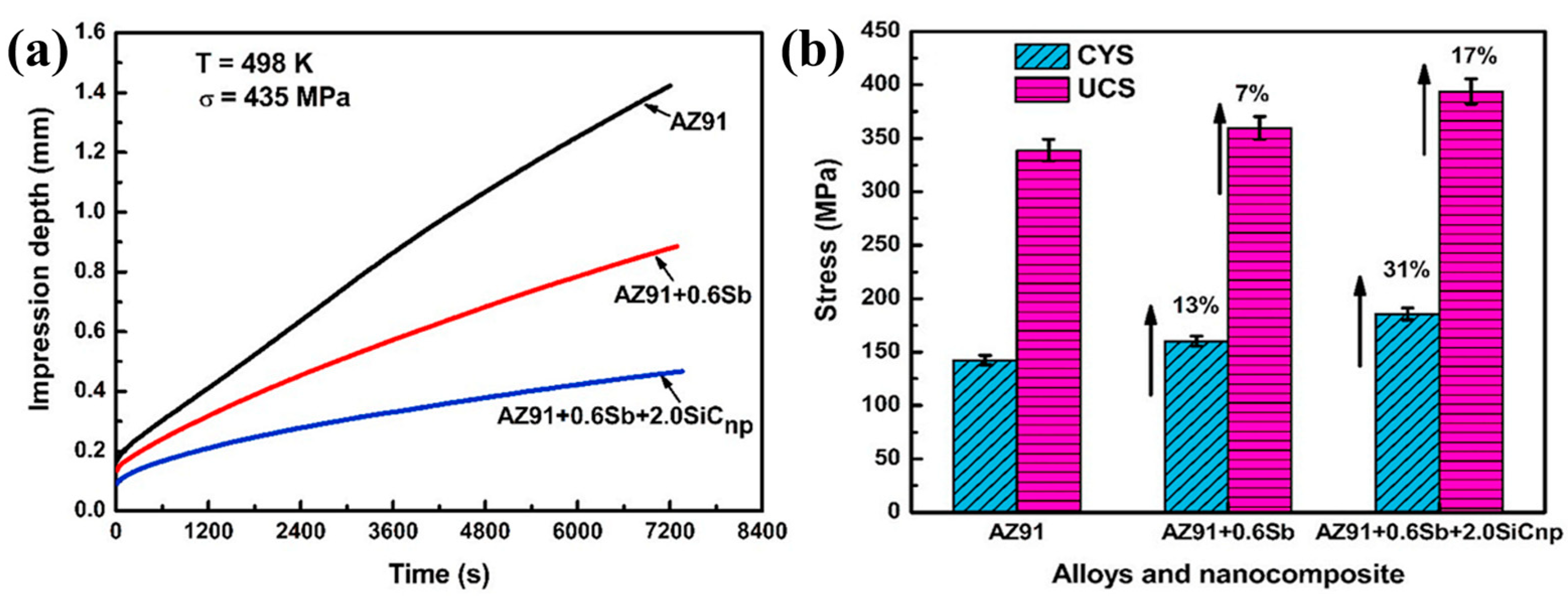
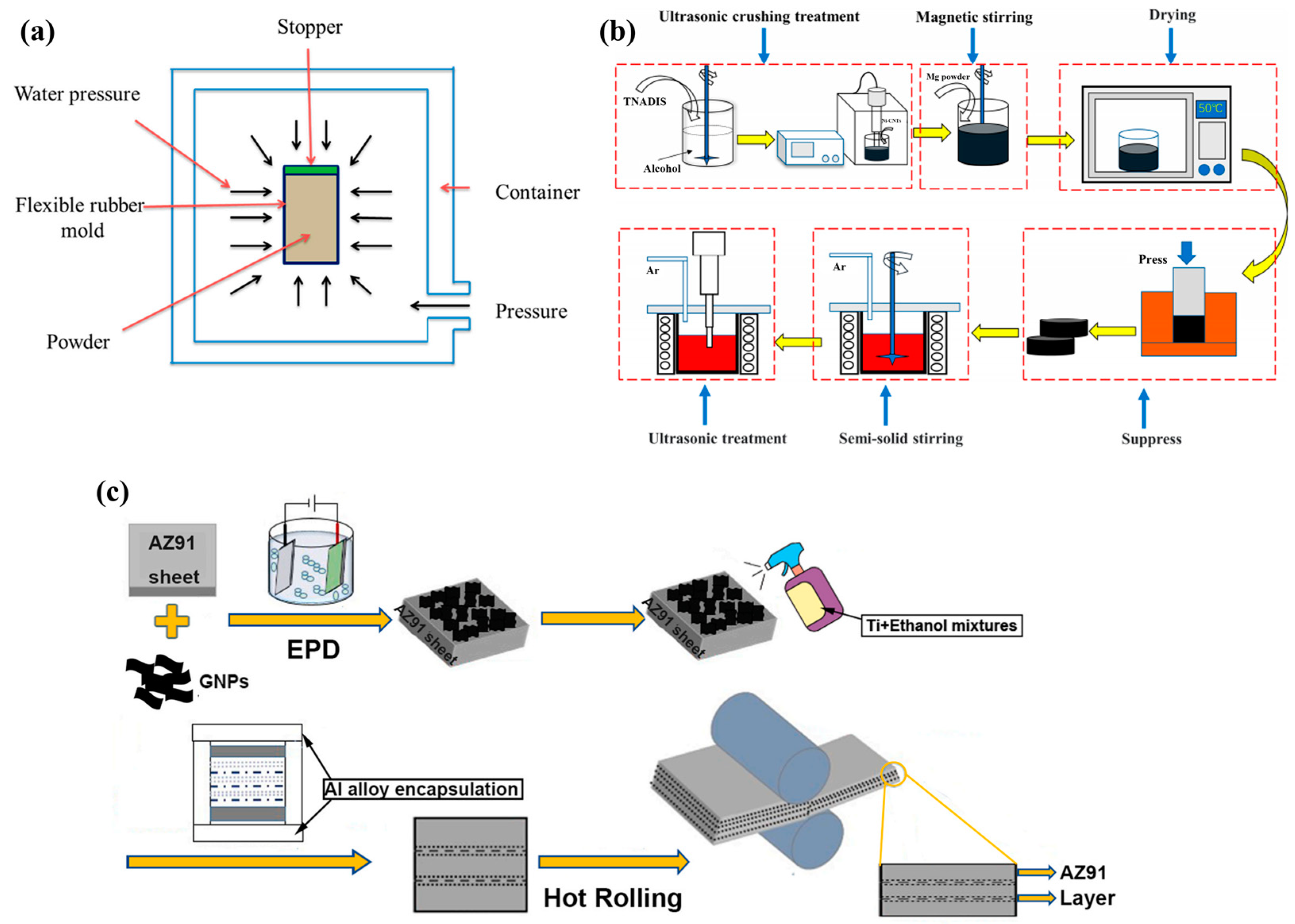


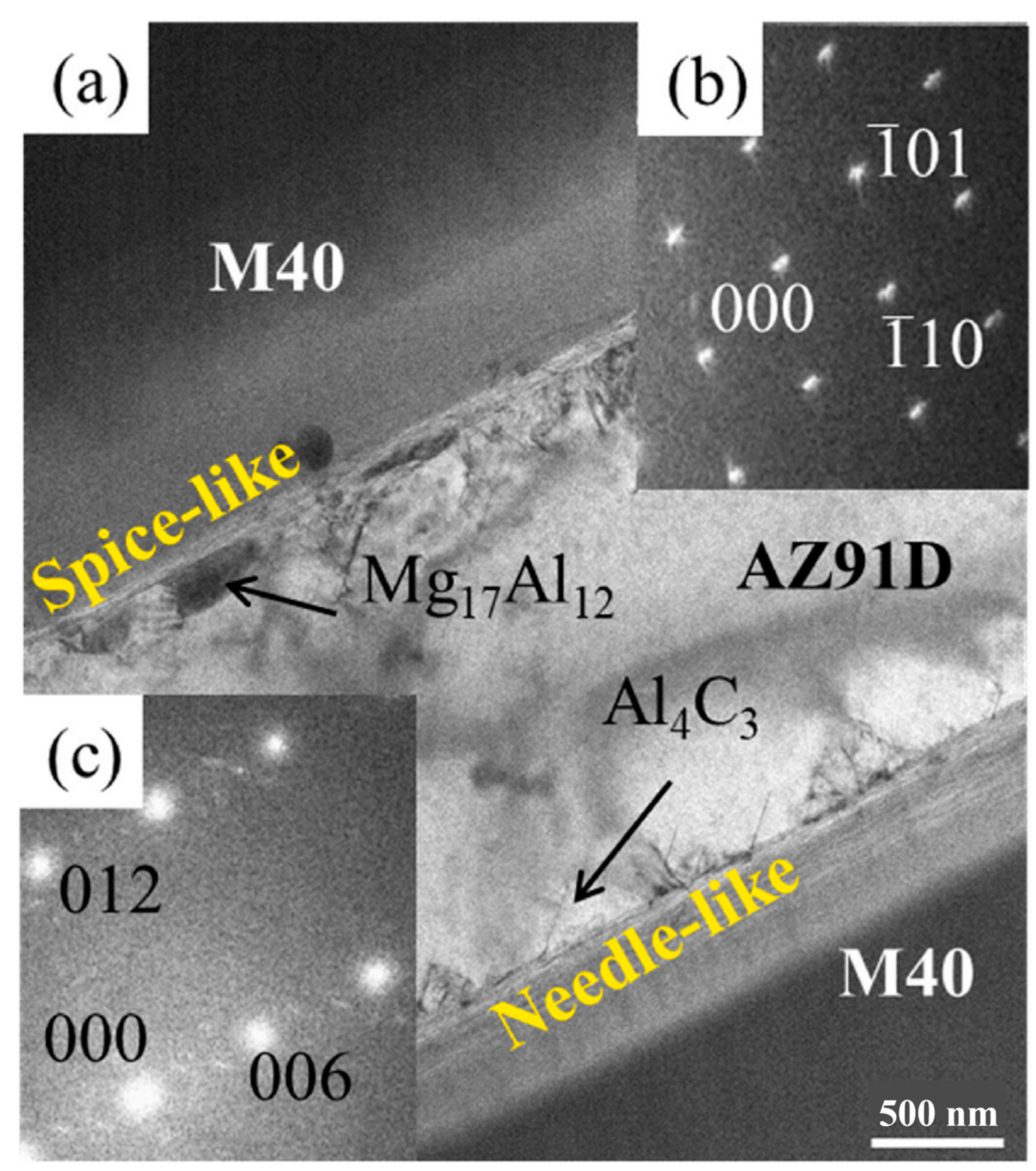
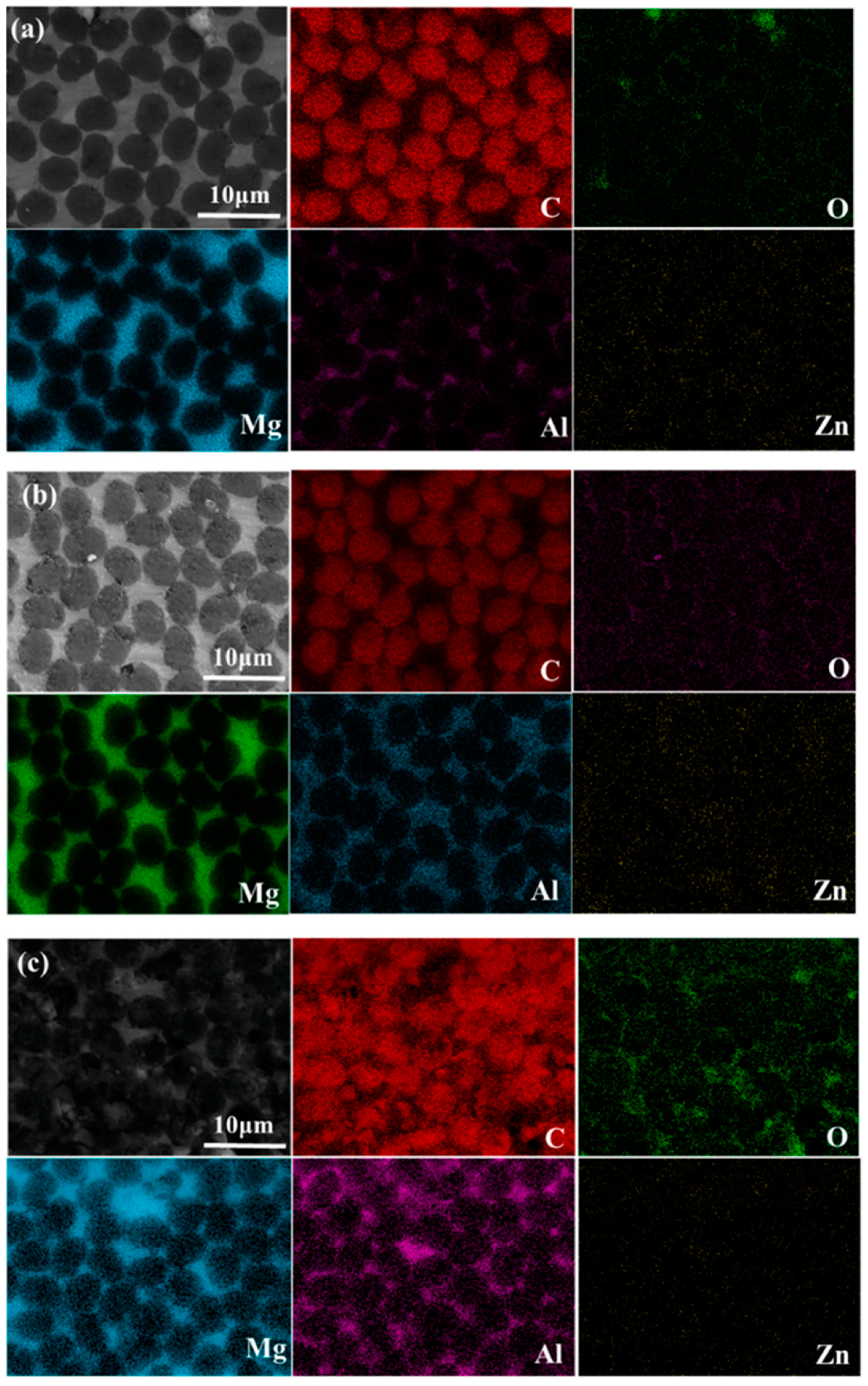
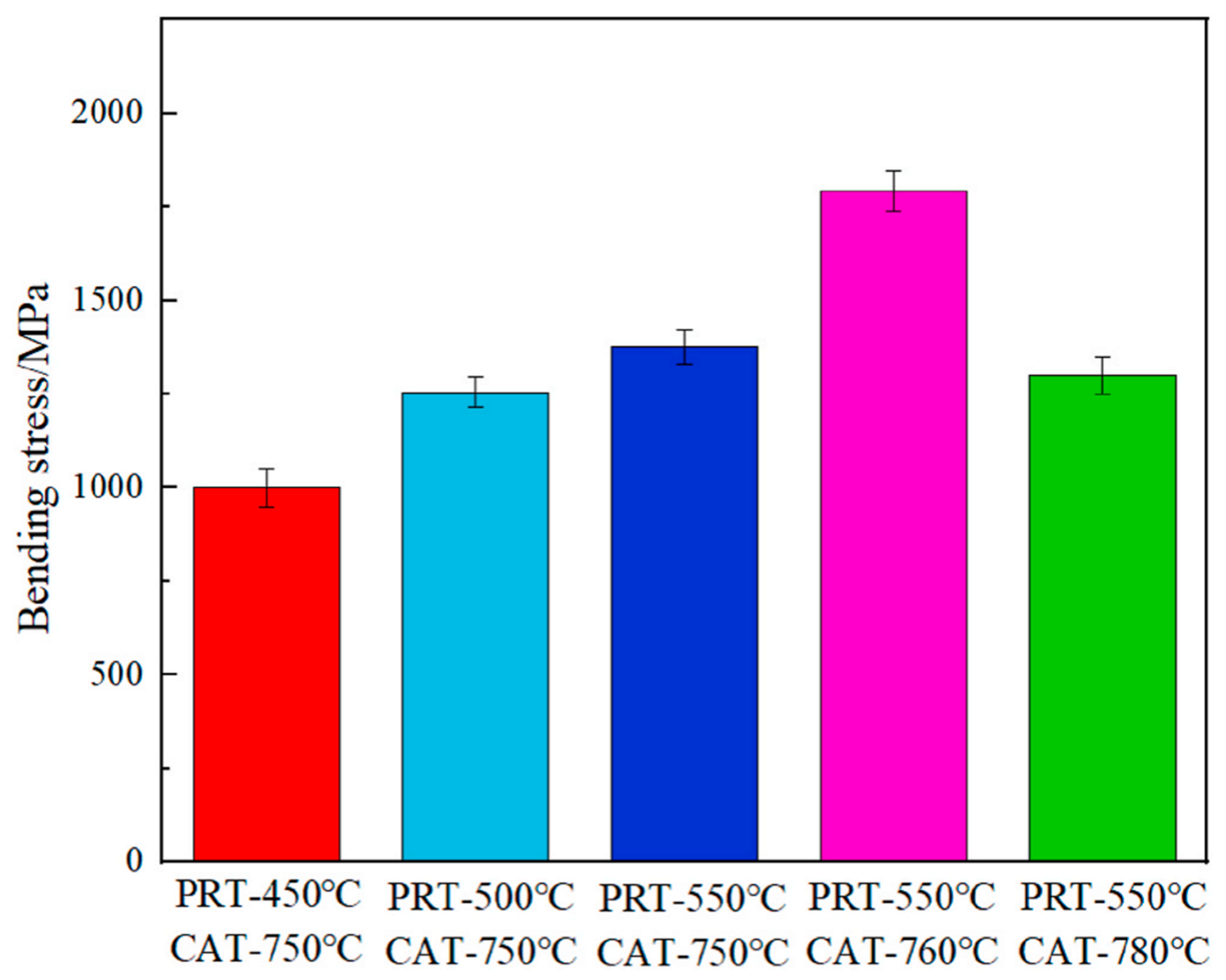




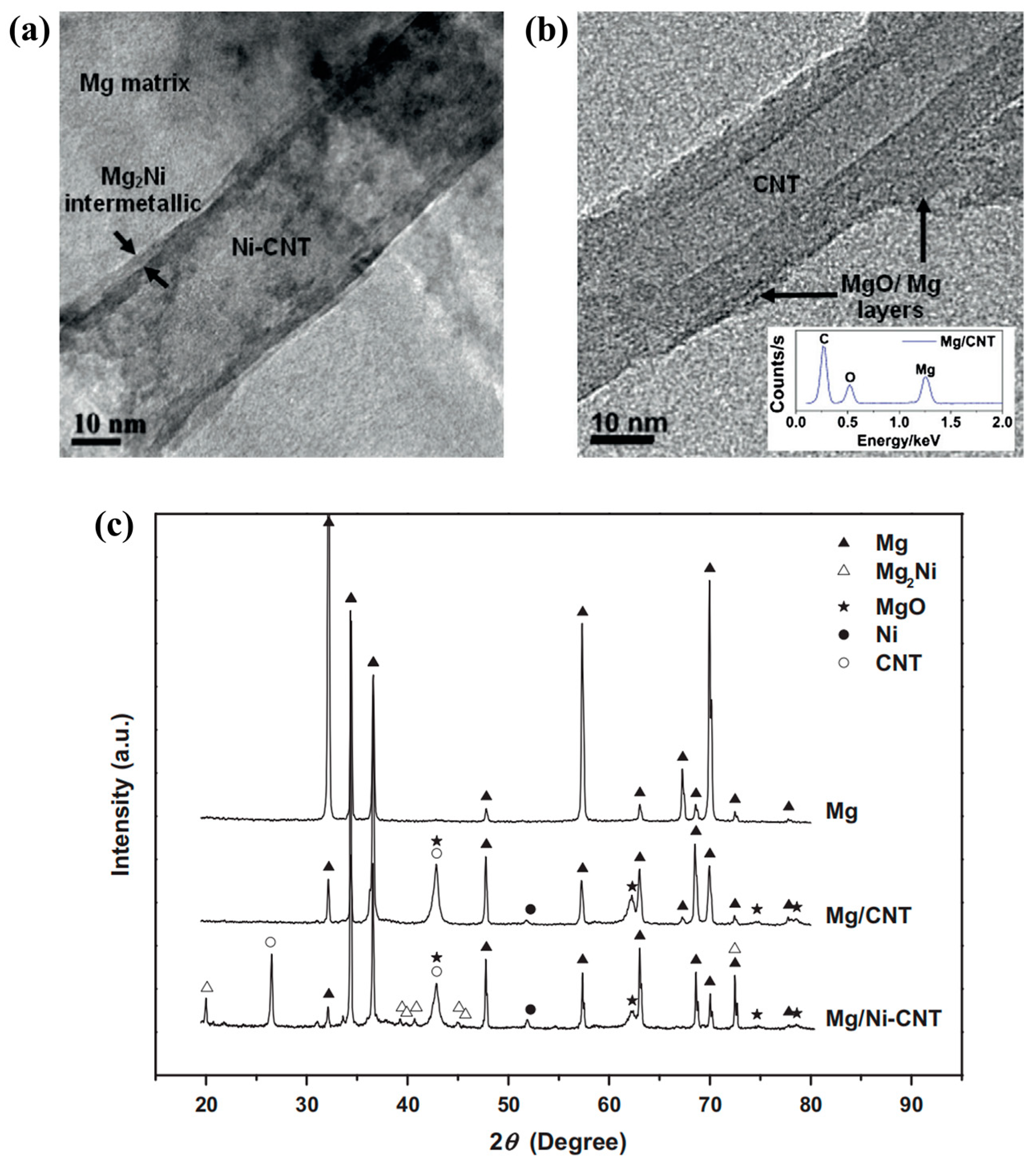
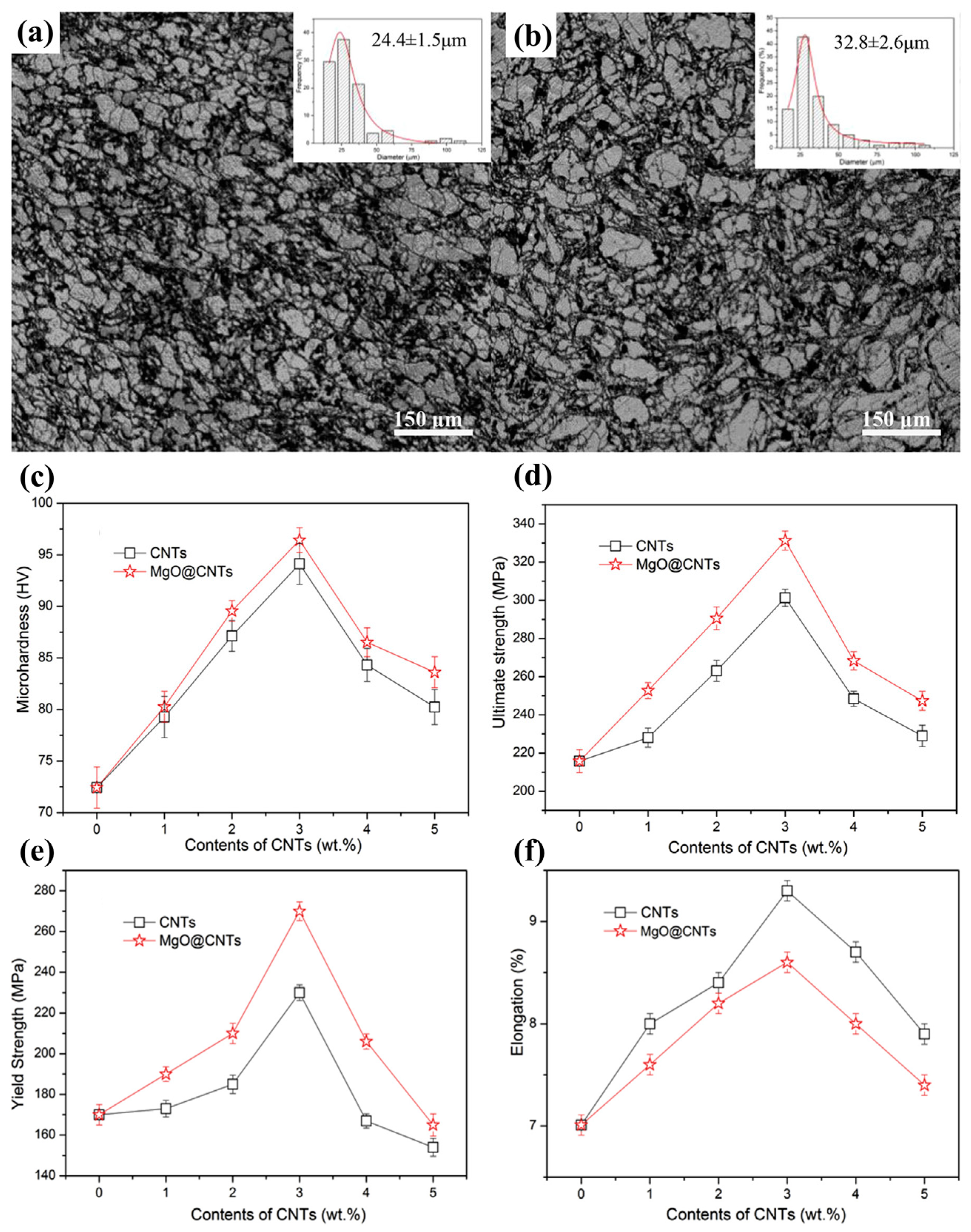

| Matrix in MMCs | Defects (Not in MMCs) | Special Properties (IN MMCs) | Refs. |
|---|---|---|---|
| AZ (Mg-Al-Zn) | (1) Low corrosion resisting (2) Low strength and hardness | (1) Excellent electromagnetic interference shielding performance (2) Preferable YS and UTS (3) Wear resistance (4) Used for additive manufacturing | [26,27] |
| WE (Mg-RE) | (1) Expensive (2) Rare earth purification | (1) Corrosion resistance (2) Creep resistance (3) Relatively cheap (compared to multi-component alloys) | [4,28,29] |
| Mg-Li | (1) Low modulus (2) Low strength and hardness | (1) Light weight (2) Specific modulus (3) Light while possessing high strength | [32,33,34] |
| Mg-Zr | Corrosion resistance | (1) Biocompatibility (2) Corrosion resistance (3) Non-toxic | [36] |
| Alloy | Reinforcement | TS (MPa) | YS (MPa) | UCS (MPa) | EL (%) | Second-Phase | Refs. |
|---|---|---|---|---|---|---|---|
| AZ31 | 15 vol% Fe–18Cr–9Ni | 355 | 241 | — | 13 | — | [53] |
| 15 vol% Ti–6Al–4V | 340 | 220 | — | 12 | — | [53] | |
| 15 vol% Al–5Mg–3Zn | 280 | 175 | — | 8 | — | [53] | |
| 0.5 wt% 3Al-Fe | 338 | 282 | — | 13.8 | Mg17Al12, Al3Fe | [52] | |
| Ti-Ni | 269 | 140 | — | — | Al3Ni2 | [49] | |
| AZ91 | 5 wt% Ti-6Al-4V | 303 | 211 | — | 18.7 | Al3Ti, Mg21(Zn, Al)17 | [47] |
| 10 wt% 0.5Al-Co-Cr-Fe-2Ni | — | — | 209 ± 8 | — | Mg17Al12 | [51] | |
| Mg-15Al-6Zn-2Cu | 3 wt% Ni | — | — | 403.7 | — | TiNi | [50] |
| Mg–3Al–1Zn | 9 wt% Ti | 294 | 264 | — | 8 | TiAl | [48] |
| Density (g/cm3) | Melting Point (°C) | Crystal Structure | Elastic Modulus (GPa) | Thermal Conductivity (W/mK) | CET (μ/K) | Refs. | ||
|---|---|---|---|---|---|---|---|---|
| oxide | Al2O3 | 3.97 | 2054 | Hexagonal | 400 | 30 | 7–8 | [47,48] |
| Y2O3 | 5.01 | 2410 | Cubic | — | 27 | 8 | [48] | |
| carbide | SiC | 3.22 | 2700 | Hexagonal | 400 | 40–60 | 5.12 | [45,52] |
| WC | 15.63 | 2870 | — | 630 | 85 | 6.9 | [46,49] | |
| nitride | AlN | 3.26 | 2249 | Hexagonal | 314 | 285 | 4.5 | [44,45] |
| BN | 2.2 | 3000 | Hexagonal | 90 | 25 | 3.8 | [42,48] | |
| boride | TiB2 | 4.52 | 3225 | Hexagonal | 565 | 60–120 | 8.1 | [4,48] |
| ZrB2 | 6.09 | 3000 | Hexagonal | 350 | 23 | 5.9 | [45,49] |
| Nitridation Reaction Times (h) | Yield Strength (MPa) | Ultimate Compressive Strength (MPa) | Compressive Fraction Elongation (%) |
|---|---|---|---|
| 0 | 93 ± 4 | 313 ± 10 | 18.1 ± 1.5 |
| 1 | 100 ± 2 | 347 ± 4 | 19.6 ± 0.4 |
| 1.5 | 108 ± 1 | 360 ± 5 | 20.3 ± 0.5 |
| 2 | 110 ± 2 | 371 ± 8 | 22.1 ± 0.4 |
| 2.5 | 95 ± 5 | 333 ± 13 | 20 ± 1.1 |
Disclaimer/Publisher’s Note: The statements, opinions and data contained in all publications are solely those of the individual author(s) and contributor(s) and not of MDPI and/or the editor(s). MDPI and/or the editor(s) disclaim responsibility for any injury to people or property resulting from any ideas, methods, instructions or products referred to in the content. |
© 2024 by the authors. Licensee MDPI, Basel, Switzerland. This article is an open access article distributed under the terms and conditions of the Creative Commons Attribution (CC BY) license (https://creativecommons.org/licenses/by/4.0/).
Share and Cite
Ren, J.-Y.; Ji, G.-C.; Guo, H.-R.; Zhou, Y.-M.; Tan, X.; Zheng, W.-F.; Xing, Q.; Zhang, J.-Y.; Sun, J.-R.; Yang, H.-Y.; et al. Nano-Enhanced Phase Reinforced Magnesium Matrix Composites: A Review of the Matrix, Reinforcement, Interface Design, Properties and Potential Applications. Materials 2024, 17, 2454. https://doi.org/10.3390/ma17102454
Ren J-Y, Ji G-C, Guo H-R, Zhou Y-M, Tan X, Zheng W-F, Xing Q, Zhang J-Y, Sun J-R, Yang H-Y, et al. Nano-Enhanced Phase Reinforced Magnesium Matrix Composites: A Review of the Matrix, Reinforcement, Interface Design, Properties and Potential Applications. Materials. 2024; 17(10):2454. https://doi.org/10.3390/ma17102454
Chicago/Turabian StyleRen, Jiao-Yi, Guan-Cheng Ji, Hao-Rui Guo, Yu-Meng Zhou, Xin Tan, Wen-Fang Zheng, Qian Xing, Jia-Yi Zhang, Jing-Ran Sun, Hong-Yu Yang, and et al. 2024. "Nano-Enhanced Phase Reinforced Magnesium Matrix Composites: A Review of the Matrix, Reinforcement, Interface Design, Properties and Potential Applications" Materials 17, no. 10: 2454. https://doi.org/10.3390/ma17102454
APA StyleRen, J.-Y., Ji, G.-C., Guo, H.-R., Zhou, Y.-M., Tan, X., Zheng, W.-F., Xing, Q., Zhang, J.-Y., Sun, J.-R., Yang, H.-Y., Qiu, F., & Jiang, Q.-C. (2024). Nano-Enhanced Phase Reinforced Magnesium Matrix Composites: A Review of the Matrix, Reinforcement, Interface Design, Properties and Potential Applications. Materials, 17(10), 2454. https://doi.org/10.3390/ma17102454








